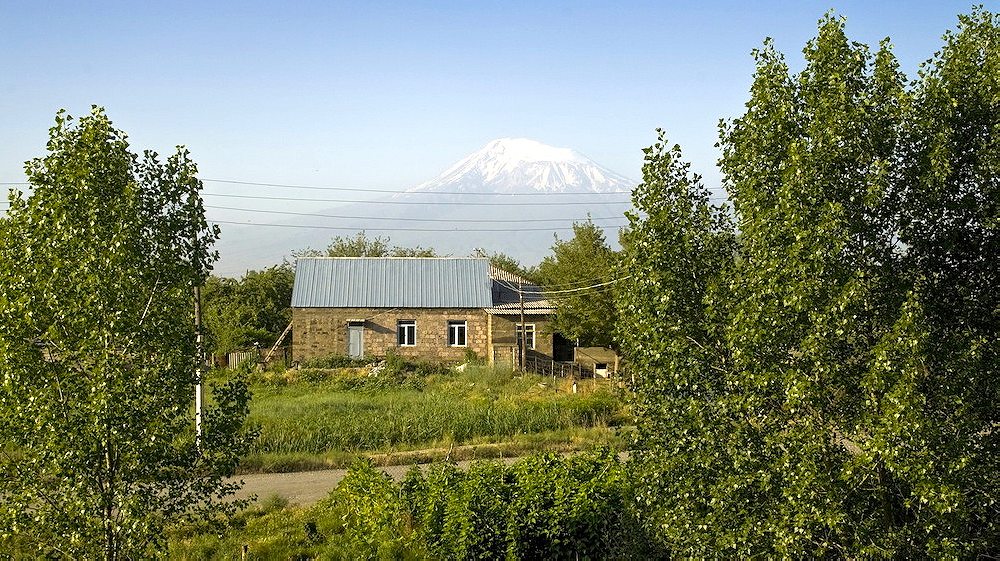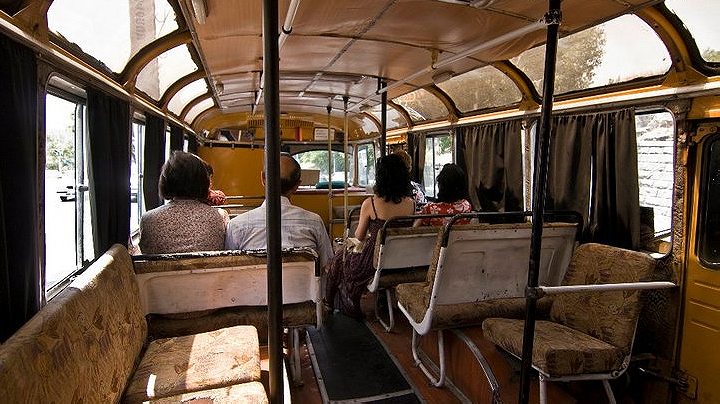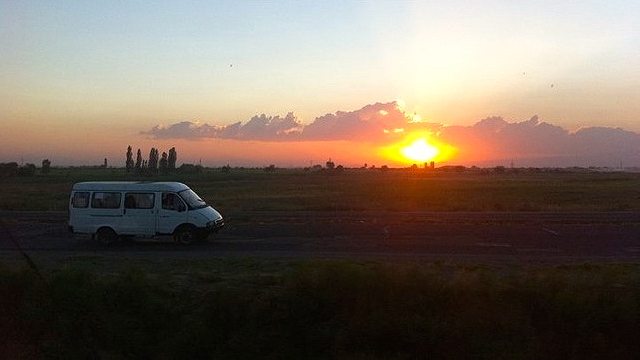Searching for identity, and a seat that actually bolts to the floor, on Armenia’s fabled marshrutka minivans.
My grandfather, an Armenian shoemaker from Tabriz, Iran, lived the last leg of his life in Southern California, a haven for Iranian and Armenian diasporas who had traded war and revolution for a bit of peace in the sun-soaked landscapes from San Francisco to Los Angeles. In his new house, thousands of miles away from air raid sirens and the nights he and my grandmother spent with my family in our Tehran basement when I was a toddler, he hung up a painting of Mount Ararat, the landing place of Noah and his ark. Even though Ararat has technically been part of Turkey for a century, the Armenians still remember it as theirs. And the mountain sits, framed, on a wall in nearly every Armenian home from Fresno to Sydney, so they can wake to its snow-capped peaks and dream of a home that once existed.
The mountain haunted me throughout my adolescence. As an adult, its pull became too magnetic to ignore. In a moment of passion, I handed in my resignation at my job as an editor. I wanted to go back, travel the length of the diasporan string that had forever tied me to my immigrant identity and tell stories in the process. My boyfriend joined in on the idea, and soon we had broken our apartment lease, crammed our belongings into my parents’ garage and headed to the South Caucasus for three months.
“There are no seats left, so you’re going to have to sit on this,” the burly Armenian bus driver said, shaking a flimsy miniature wooden stool in the air.
A faint laugh escaped from my lips. I thought he was joking.
He was not.
I watched family members who stayed behind wave goodbye to their loved ones and looked up to the see the bus completely full, the faces of passengers brimming with stories hidden in wrinkles and creases pressed against the foggy windows.
This detail, of course, did not matter to our bus driver.
With one big push, he wedged the worn stool, called a “taburetka” in Russian, tightly between two pleather seats on the bus and shook his hands vigorously once more, beckoning me to get in.
He then turned in the direction of my horrified boyfriend who was trying to convince me to wait for a roomier bus that would come by tomorrow morning, but it was too late. We were both mute by then. “You. Sit in the front with me,” the bus driver said, hauling him away.
As a woman, I wasn’t eligible for the front seat. In the patriarchy-soaked South Caucasus, the idea of a woman sitting for hours on end in the company of a male driver was too bold, too taboo. I didn’t understand this at the time, but weeks later on another trip, I watched a woman miss out on a ride despite the seat next to the driver remaining bare.
It was the middle of summer and the relentless Armenian sun lit up the shimmery flecks on her opaque panty hose.
“Can someone at least move upfront so I can get a seat in the back?” she called as she stuck her head in the bus.
No one budged. The bus drove away, leaving her shadow outlined in the amber colored dust.
Instinctively, I reached for a seat belt and soon realized that I was, in fact, sitting on an unbolted stool in the middle of a van bursting at the seams with bodies. The only thing forcing my chair to stay in its place through a mountainous journey across Armenia and into neighboring Georgia was the weight of my own backside and the fleshy hips of the big-boned women on each side of me.
This was not just any bus. This was a marshrutka—Russian for “routed taxi”—the mythical minivans used throughout most of the former Soviet Union that give new meaning to the concept of public transportation. Sturdy and cheap to both operate and ride, the marshrutkas are the only things strong enough to withstand the raw South Caucasian roads. In Armenia, they are the most common mode of travel both city and countrywide, and for less than $5, they got me to the capital of another country in record time.
The marshrutka, with its rattling floorboards, rusty exterior and baseball-card sized photos of Jesus and the Virgin Mary plastered to the dashboard, was filled with the wafting odor of fried meat piroshki and potato-filled buns. An evil eye pendant, used to ward off danger in this part of the world, hung from the rear view mirror and swung like a pendulum, capturing every single pothole in its stride. The windows remained closed, despite the dry summer heat. The driver continued to smoke, despite a smoking ban for marshrutka drivers. And more people continually climbed on board, despite a dangerously depleting oxygen supply.
For hours, my legs remained buried under oversized luggage. Without thinking twice, the overwhelmed mother sitting next to me plopped her crying infant onto my lap. The constant swerving by our driver combined with copious amounts of sweets proved too much for my newly adopted 2-year-old. The rest of the ride, with a stop at the border where the circulation slowly came back in my limbs, was spent helping his mother clean him, while she tossed bags of projectile vomit out the window into the picturesque Caucasian hills.
The most dangerous threat the marshrutka carried however, wasn’t vomiting children, but grandmothers, who, noticing my male travel companion, turned to sweetly ask if we were married. I quickly learned, that unless I was prepared for silent scorn, I had to fib and enthusiastically nod “yes.” In turn, they rewarded me with smiles and handfuls of exotic Russian candy.
The marshrutka had no buttons to push to get off, no chords to pull, no announcements about where we were. If you could manage, an enthusiastic “stop” from the barrels of your gut that echoed through rows of intimidating locals who carried everything from groceries to bulky furniture, did the trick. The worn-in seats jiggled back and forth, vibrating to loud nostalgic Russian pop songs as the driver negotiated the pockmarked mountainous roads. I sat on a stool in a 12-seat bus that had probably seen the fall of the USSR, with 20 other people, suffering through children with uneasy stomachs and ear-numbing music. Passengers struck up conversations that ended with invites insisting we spend the night at their house. It was terrible and wonderful at the same time, and I loved every single minute of it.

The Caucasus is a place where the road to love and hate run parallel and intertwine, where anything and nothing is possible, where tea and blood boil in the same pot. Armenia lies in its southern tip, its borders continuously fought over by vast empires, its diaspora spread throughout every corner of the world, divided by genocide, immigration, communism and war.
Its collective psyche, romantically shackled to the past and longing for the future without much regard for the present, could be defined by the singular striking image that haunted me, the snow-capped peaks of biblical Mount Ararat. Beyond the walls of diaspora homes, it appeared on posters, in books, even crudely taped down on the check-out counters of ethnic Armenian grocery stores and printed on the labels of jams and juices on their isles.To the world, Ararat was in Turkey. To Armenians, it would always remain theirs. I often saw Mount Ararat while on my marshrutka trips and wondered about my identity as part of a diaspora created through survival rather than choice.
Just a couple hours away from Tbilisi, the marshrutka came to a slow stop. A herd of cows passed through and in these hills, they always had the right of way.
I remembered my grandfather, who would spend hours sitting in a sun-bathed corner of his house rubbing rosary beads between his wrinkled hands and dreaming of his ascent to Ararat. I would find him with his eyes full of tears looking out of the window, half-expecting Ararat to appear. When he died, I dreamt that he had floated in his sleep across the ocean and found his final resting place in its snowy peaks.
The herd moved along the bumpy road in southern Georgia and so did the marshrutka. I, too, had felt like I was moving, and leaving beyond the frames of the oil painted-mountain neatly hung against the wall.
“I am looking for the people who have always been there and belong to the places they live,” travel writer Norman Lewis once said.
But with a growing diaspora uprooted and displaced at various junctions throughout history, the idea of ‘home,’ of belonging, had never really settled in. It was not Ararat, but the roaming marshrutka that was encompassing the soul of Armenia for me. Home was a dusty minivan plastered with placards of the Virgin Mary that was full of people and always stopped for cows. The marshrutka was the embodiment of Armenia’s gravitational pull that jerked you back no matter how far away you were—a ground zero for the world’s opposite forces, destined to live so closely intertwined: love and hate, peace and war, joy and pain, rich and poor.
There were upscale taxis and even tour buses commonly used by diasporan groups that would have perhaps been a more logical choice for the trip my boyfriend and I took, but the decision to ride across the country in marshrutkas was, ultimately, the right one. The lack of safety, the strangers who spoke to me as if I was one of their own, was thrilling. It taught me that identity doesn’t stop at kebab shops or paintings of snowy mountains. Identity expands and changes and if you let it, it makes room for new narratives. Being Armenian, for me, now also means riding around in a decrepit minivan among locals with stories to tell, the wind furiously blowing in your face while sitting on an unbolted wooden stool.

Giddy from the long ride and the melt-in-your-mouth apricots Armenia is famous for, we took more marshrutka adventures after we crossed the Armenia-Georgia border. We soon headed to Nagorno-Karabakh, the de facto republic that was the scene of a bloody war between Armenia and neighboring Azerbaijan in the early 90s. The physical and psychological scars of the ‘frozen’ conflict remain. Even today, the only way to enter Karabakh is through Armenia, which retains control of the landlocked region.
Traveling there by marshrutka did not require much thought, but I couldn’t decide if it was misfortune, or perhaps luck that led me back to the wooden stool again.
“Problem chika. Problem chika,” the driver said as he pulled the taburetka out from the van’s trunk. “There won’t be a problem, there won’t be a problem.”
I spent much of the journey grabbing onto anything I could find inside the van—the door, seats, my boyfriend’s legs—that I thought would keep me remotely stable, while we twirled up and down deep within the forested Caucasus mountains. I caught our driver smirking in the rear view mirror.
Droplets of sweat swelled beneath my cardigan, dancing to the soundtrack of Russian love ballads. From Karabakh’s capital, Stepanakert, we rode another van to Shushi, visited a defunct mosque—its damaged minarets still showing signs of the war—and ate watermelon with two elderly men in the town square who happily told us the sad, rich stories of Shushi’s past.

On the day we had intended to leave Karabakh, a bus strike began. With time to waste, we ventured to the back of the station, randomly picked a minivan and hopped on. The mountains hugged the marshrutka as it chugged up the landscape, Stepanakert no longer in sight.
We were anomalies on the bus, foreigners who spoke Armenian. A woman turned around and enthusiastically practiced her limited English with us. A family cajoled us into coming home with them. In the West, receiving an invitation from a stranger on a bus might make you change your seat. In the hospitable Caucasus, refusing it is tantamount to committing murder.
Lost in the ancient city of Amaras, where Mesrop Mashtots, the founder of the Armenian alphabet, established his first school, we found ourselves sitting on a mattress in a backyard with small children, wild chickens and a vineyard as our backdrop. I gritted fresh honeycomb between my teeth as our hosts poured the thick, mud-like Armenian coffee I had once hated back home, but now couldn’t wait to drink.
On the long drive back to the bus station, we stopped to rest at a waterfall. “Here,” our new host Anahit said, handing me a plastic cup. “Drink.” The waterfall was a good omen, the bearer of much luck. The crisp water slid down my throat, its essence—or maybe its luck—lingering there for hours.
Back in Armenia, we traveled to Gyumri with locals, a glorious city once part of the Silk Road still reeling from an earthquake that left upwards of 25,000 dead. What it lacked in infrastructure, it made up in immense, and at times overpowering, soul. During Vartavar, a national water festival, we went to Garni, a village that was the site a pagan-era temple of the same name. We hopped back on the marshrutka completely drenched. The damp van reeked as we passed decrepit Soviet buildings left unfinished for decades. We almost missed the marshrutka to Ashtarak, spending half of the 20-cent journey catching our breath while cheap, Soviet-era cars with watermelon-filled trunks drove by. In the Southern Armenian city of Sisian, we attended a pagan new year festival on the 3500-year-old site of Zorats Karer, an astronomical wonder older than Stonehenge.
Months after I left Armenia, I found out the marshrutkas were slowly being phased out, set to be replaced with shiny, new buses. They will have no Virgin Mary photos or wooden stools, but rather leather seats and clean dashboards and perhaps even seat belts. The vomiting children however, would always be around.
The change won’t take place for a few years, but I have hung a framed photo of a marshrutka on my wall back home in the U.S., just in case I can’t make it back in time.